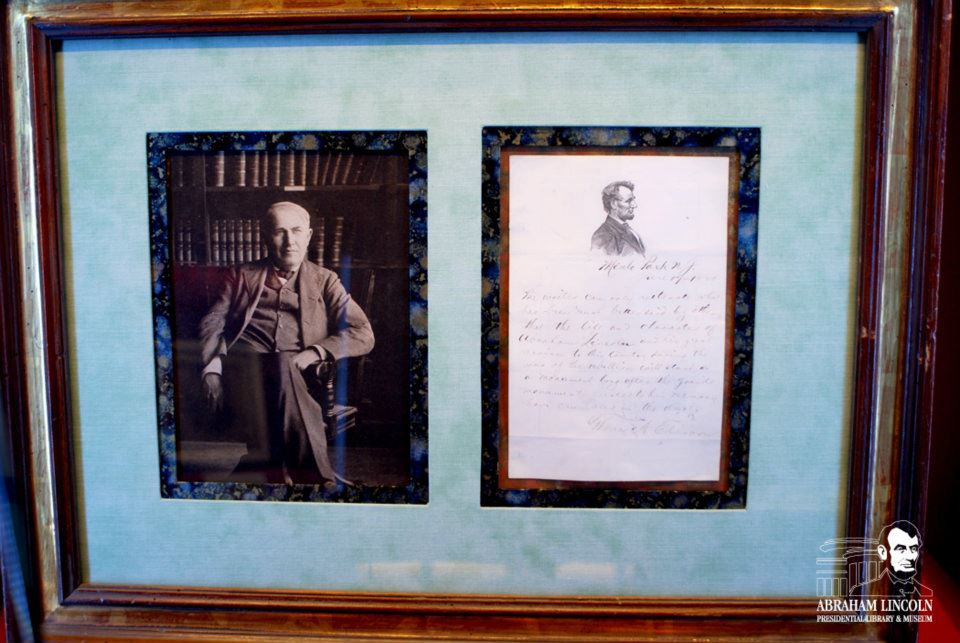Thomas Edison was 14 years old when the Civil War broke out, but already learning how to send and received telegraph messages. Which is how he began his Abraham Lincoln connection. During the Civil War, the telegraph had become a critical means of communication, both to get news from the front and to relay strategies and orders from President Lincoln and Secretary of War Stanton. A popular song of the era captured the essence of the power of the telegraph:
For our mountains, lakes and rivers, are all a blaze of fire
And we send our news by lightning, on the telegraphic wire.
Edison spent the rest of the war working the telegraph lines safely ensconced in northeastern Michigan. After the war, Edison built his own business modifying telegraphs to send and receive on multiple channels, as well as print out the messages and automatically convert the dots and dashes into text. Much of his early work was sold to Western Union, that is until its Superintendent Thomas T. Eckert – who had been in charge of Lincoln’s telegraph office during the war – jumped ship to the Atlantic & Pacific Telegraph Company and convinced Edison to sell his new quadruplex telegraph rights to them.
About ten years later Edison had moved on to invention of the tinfoil phonograph. In April 1878 he took it to Washington, D.C. for a demonstration of the National Academy of Sciences, created in 1863 by Abraham Lincoln. There he met Joseph Henry, then doing double duty as Secretary of the Smithsonian Institution and President of the National Academy. Henry had been Lincoln’s unofficial science adviser during the Civil War. The demonstration went so well that Edison was asked to bring the phonograph up the road to the White House, where he demonstrated it in a personal audience with President Rutherford B. Hayes and guests into the wee hours of the morning. Lincoln friend and now Secretary of the Interior Carl Schurz played a lively tune on the piano. Ironically, Edison was so deaf by this point that his colleague Charles Batchelor had done most of the presentation at the National Academy. At the White House, Edison chimed in with his off-yelled rendition of “Mary had a little lamb” and other ditties.
Still later, Edison invented what became the film projector. One of his most famous early films was The Life of Abraham Lincoln. A silent film (with musical soundtrack) presenting highlights from Lincoln’s life, The Life expanded the length of motion pictures and now took up two reels. The Life was a “two-part drama” that ran “from the scene in front of the log cabin to the assassination at Ford’s Theater in Washington.” The sales catalog claimed, “Nothing has been left undone to make this a consummate review of Lincoln’s life.” For the 100th anniversary of Lincoln’s birth in 1909, Wanamaker’s huge department store in lower Manhattan hosted a screening of Edison’s ten-minute film The Blue and the Grey, or the Boys of ’61, accompanied by “favorite war songs” of the era.

Edison was so enamored of Lincoln “that he placed Lincoln’s profile on his own letterhead, and wrote out this testimonial in 1880:
” … the life and character of Abraham Lincoln and his great services to this country during the war of the rebellion will stand as a monument long after the granite monuments erected to his memory have crumbled in the dust.”
The photo shown is in the collection of the Abraham Lincoln Presidential Library and Museum in Springfield, IL.
As I think back on my own admiration of Lincoln it strikes me that there are a number of connections between the three topics of my published books – Tesla, Edison, and Lincoln. Perhaps I was destined to write about all three.
David J. Kent is an avid science traveler and the author of Lincoln: The Man Who Saved America, in Barnes and Noble stores now. His previous books include Tesla: The Wizard of Electricity and Edison: The Inventor of the Modern World and two specialty e-books: Nikola Tesla: Renewable Energy Ahead of Its Time and Abraham Lincoln and Nikola Tesla: Connected by Fate.
Check out my Goodreads author page. While you’re at it, “Like” my Facebook author page for more updates!










